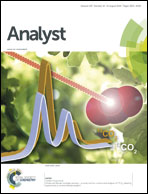Differential pulse voltammetry detection of dopamine and ascorbic acid by permselective silica mesochannels vertically attached to the electrode surface†
Abstract
A thin film consisting of highly ordered and vertically oriented silica mesochannels (SMCs) was prepared on the indium tin oxide (ITO) coated glass electrode surface by chronopotentiometry. The mesochannel has a uniform pore size of 2–3 nm in diameter and a positively charged surface due to grafted ammonium groups. The electrostatic and steric effects resulted from control of the surface charge and the ionic buffer concentration make the SMCs permselective, favoring the mass transport of oppositely charged species and repelling that of similarly charged ones. By using differential pulse voltammetry (DPV), the SMCs with this charge selectivity can be employed for permselective detection of ascorbic acid (AA) and dopamine (DA) that are oppositely charged compounds. The obtained linear detection range was 49–2651 μM for AA and 20–226 μM for DA, respectively. AA and DA in real samples were also determined by the SMC film modified electrode.


 Please wait while we load your content...
Please wait while we load your content...